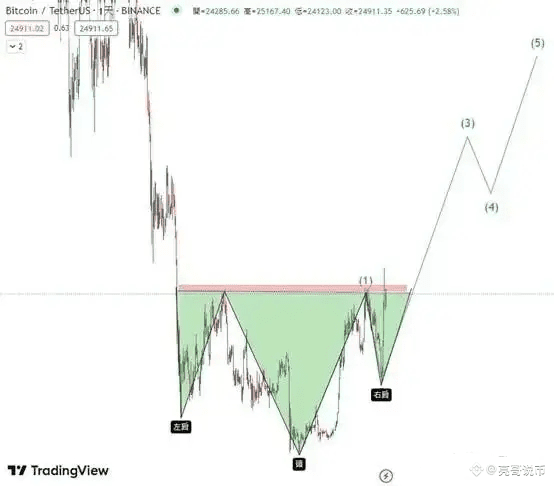1. The Most Stable Play in Cryptocurrency Contracts
Choose the right cryptocurrencies and be a good person. As a leveraged trader, volatility can be magnified by leverage, so during trading, the primary consideration should not be volatility but certainty.
Go long on strong cryptocurrencies during an uptrend and short on the weakest cryptocurrencies during a downtrend.
For example, at the start of a new quarter, the strongest performers are EOS and ETH. For pullbacks, these two cryptocurrencies should be your first choice for going long, while Bitcoin should be your first choice for shorting during a decline. Even if the final outcome is that mainstream coins decline more than Bitcoin, only shorting or chasing Bitcoin can greatly avoid the risk of violent rebounds.
Most players in the cryptocurrency world are short-term traders. When trading, it is challenging to hold out for ideal exit points, and many are not proficient in position control, nor can they rely on fluctuations to average the price. In light of this situation, for most traders, a good entry price is more valuable than anything else.
Once you make a profit, take some off the table for safety, and set a stop-loss at the cost price for the remaining amount. This is something I have always emphasized in my community.
The essence of contract trading strategies
(1) Identify the main trend and trade in the direction of that trend; otherwise, do not enter the market.
(2) If you are trading with the trend, the entry points are:
1. New breakout points in the trend;
2. Breakout points from sideways consolidation moving in a certain direction;
3. Pullback points in an uptrend or rebound points in a downtrend.

(3) Following the trend can bring you substantial profits, so never exit too early;
(4) If the position aligns with the larger trend, and the paper profit proves you are correct, you can use pyramid-style techniques to increase your position; (Refer to section two)
(5) Keep the position unchanged until the trend reverses and closes the position.
(6) If the market trend is contrary to your position, cut losses quickly.
In addition to adhering to the above strategies, remember three qualities: Discipline, discipline, and still discipline!
The way of trading is to accumulate small amounts into large ones, compounding is king. If you deviate from your costs, you must resolutely avoid turning back into losses. If you have made a profit, definitely take some to prevent it from being in vain. In summary: If you earn, be bold; if not, take original losses.
2. Tips for Making Money with Perpetual Contracts
1. Avoid being fully invested
How should funds be allocated? Fund allocation should be understood from two perspectives:
First, from the risk perspective, clarify how much loss our account can or is prepared to endure. This is the foundational thought for our fund allocation. Once this total is determined, consider how many times we can afford to lose to the market if we continuously fail.
I personally believe that the riskiest method should also be divided into three attempts. In other words, you should give yourself at least three chances. For example, if the total account funds are 200,000, and the maximum loss allowed is 20% or 40,000, then I suggest the riskiest loss plan as follows: the first loss of 10,000, the second loss of 10,000, and the third loss of 20,000. I believe this loss plan has a certain degree of rationality. If you succeed once out of three attempts, you can make a profit or continue to survive in the market. Not being kicked out by the market is already a form of success, which provides winning opportunities.
2. Grasp the overall market trend
Trends are much harder to trade than fluctuations because trends involve chasing up and selling down, requiring perseverance in holding positions, while buying high and selling low aligns more with human nature.
Trading is about adhering to human nature; if it aligns too much, it's hard to make money. It's because it's difficult that it can be profitable.
In an upward trend, any violent pullback should be an opportunity to go long. Remember the probability I mentioned? So, if you’re not in the trade, or if you exited, wait patiently for a drop of 10% to 20% and then be bold to enter long.
3. Set stop-loss and take-profit targets
Setting stop-loss and take-profit can be said to determine whether you can make a profit. In several trades, we need to ensure that total profits exceed total losses. Achieving this is not difficult, just follow these points:
① Each stop-loss ≤ 5% of total funds;
② Each profit > 5% of total funds;
③ Total trading win rate > 50%
Meeting the above requirements (profit-loss ratio greater than 1 and win rate greater than 50%) can lead to profits. Of course, you can also have a high profit-loss ratio with a low win rate or a low profit-loss ratio with a high win rate. Anyway, as long as you ensure total profits are positive, total profits = initial capital × (average profit × win rate - average loss × loss rate).
4. Remember not to trade too frequently
Since BTC perpetual contracts trade 24/7 without interruption, many newcomers operate daily, wishing to trade every day during the 22 trading days of the month. As the saying goes: If you walk by the river often, how can you avoid getting wet? Trading too much will inevitably lead to mistakes, and after making a mistake, your mindset will deteriorate. Once the mindset changes for the worse, you may impulsively choose 'revenge' trading: possibly against the trend, possibly with heavy positions. This can lead to a series of mistakes, easily causing significant losses on paper, which may take years to recover.
3. What types of contracts are there?

1. Perpetual Contracts: Perpetual contracts have no expiration date, and users can hold them indefinitely, performing their own closing operations.
2. Delivery Contract: Delivery contracts have specific delivery dates, including contracts for this week, next week, this quarter, and next quarter. When the specific delivery date arrives, regardless of profit or loss, the system will automatically settle.
3. USDT Margin Contracts: These require you to use the stablecoin USDT as collateral. As long as you have USDT in your account, you can trade multiple cryptocurrency contracts, with profits and losses settled in USDT.
4. Coin-Margin Contracts: These contracts use the underlying cryptocurrency as collateral, requiring you to hold the corresponding cryptocurrency before trading, with profits and losses settled in that cryptocurrency.
This concludes the trading experience shared by Liang Ge today. Often, your doubts lead to missed opportunities for profit. If you do not dare to boldly try, engage, and understand, how will you know the pros and cons? Only by taking the first step will you know how to proceed next. A warm cup of tea, a piece of advice, I am both a teacher and a friendly conversationalist.
Meeting is fate, knowing is destiny. Liang Ge firmly believes that destiny will eventually bring people together, while lack of fate leads to mere encounters. The journey of investment is long, and temporary gains and losses are just the tip of the iceberg. Remember, even the wisest can make mistakes, and even the foolish can find success. Regardless of emotions, time will not stop for you. Pick up your troubled heart, stand up, and move forward.
Playing around in the cryptocurrency world is essentially a battle between retail investors and major players. If you lack cutting-edge information and firsthand data, you can only be at risk! If you want to strategize and harvest from the big players, you can follow Liang Ge and welcome like-minded people in the cryptocurrency world to discuss together~
The secrets of trading have been shared with you all; whether you can achieve fame in the community depends on your own efforts.#特朗普施压鲍威尔 $BTC


